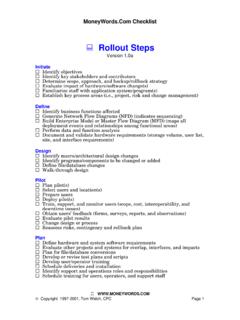Transcription of Recovery Project Management: Techniques and …
1 I nte r n at i o n a l I n st i t u te fo r L e a r n i n g , I n c . Recovery Project Management: Techniques and Tactics For Reversing Failing ProjectsBy Harold Kerzner, Sr. Executive Director for Project ManagementInternational Institute for Learning, Troubled ProjectsProfessional sports teams treat each new season as a Project . For some teams, the only definition of success is winning the championship, while for others success is viewed as just a winning season. Not all teams can win the championship, but having a winning season is certainly within the end of the season, perhaps half of the teams will have won more games than they lost. But for the other half of the teams who had losing records, the season ( Project ) was a failure.
2 When a Project failure occurs in professional sports, managers and coaches are fired, there is a shakeup in executive leadership, some players are traded or sold to other teams, and new players are brought on board. These same tactics are used to recover failing projects in are some general facts about troubled projects: Some projects are doomed to fail regardless of Recovery attempts The chances of failure on any given Project may be greater than the chances of success Failure can occur in any life cycle phase; success occurs at the end of the Project Troubled projects do not go from green to red overnight There are early warning signs, but they are often overlooked or misunderstood Most companies have a poor understanding of how to manage troubled projects Not all Project managers possess the skills to manage a troubled projectNot all projects will be successful.
3 Companies that have a very high degree of Project success probably are not working on enough projects and certainly are not taking on very much risk. These types of companies eventually become followers rather than leaders. For companies that desire to be leaders, knowledge on how to turn around a failing or troubled Project is do not get into trouble overnight. There are early warning signs, but most companies seem to overlook them or misunderstand them. Some companies simply ignore the tell-tale signs and continue on hoping for a miracle. Failure to recognize these signs early can make the cost of downstream corrections a very costly endeavor. n Understanding Troubled Projectsn Root Causes of Failuren The Definition of Failuren Early Warning Signs of Troublen Selecting the Recovery Project Manager (RPM)n Recovery Life Cycle Phases I nte r n at i o n a l I n st i t u te fo r L e a r n i n g , I n c.
4 Also, the longer you wait to make the corrections, the more costly the changes companies perform periodic Project health checks. These health checks, even when applied to healthy looking projects, can lead to the discovery that the Project may be in trouble even though on the surface the Project looks healthy. Outside consultants are often hired for the health checks in order to get an impartial assessment. The consultant rarely takes over the Project once the health check is completed, but may have made recommendations for a Project gets way off track, the cost of Recovery is huge and vast or even new resources may be required for corrections. The ultimate goal for Recovery is no longer to finish on time, but to finish with reasonable benefits and value for the customer and the stakeholders.
5 The Project s requirements may change during Recovery to meet the new goals if they have changed. But regardless of what you do, not all troubled projects can be recovered. Root Causes of FailureThere are numerous causes of Project failure. Some causes are quite common in specific industries, such as information technology, whereas others can appear across all industries. Below is a generic list of common causes of failure: End user stakeholders not involved throughout the Project Minimal or no stakeholder backing; lack of ownership Weak business case Corporate goals not understood at the lower organizational levels plan asks for too much in too little time Poor estimates, especially financial Unclear stakeholder requirements Passive user stakeholder involvement after handoff Unclear expectations Assumptions, if they exist at all.
6 Are unrealistic Plans are based upon insufficient data No systemization of the planning process Planning is performed by a planning group Inadequate or incomplete requirements Lack of resources Assigned resources lack experience Staffing requirements are not fully known Constantly changing resources Poor overall Project planning Enterprise environmental factors have changes causing outdated scope Missed deadlines and no Recovery plan Budgets are exceeded and out of control Lack of replanning on a regular basis Lack of attention provided to the human and organizational aspects of the Project Project estimates are best guesses and not based upon history or standards Not enough time provided for proper estimating No one knows the exact major milestone dates or due dates for reporting Team members working with conflicting requirements People are shuffled in and out of the Project with little regard for the schedule Poor or fragmented cost control Each stakeholder uses different organizational process assets, which may be incompatible with the assets of Project partners Weak Project and stakeholder communications Poor assessment of risks if done at all Wrong type of contract Poor Project management .
7 Team members possess a poor understanding of Project management , especially virtual team members Technical objectives are more important than business objectivesThese causes of Project failure can be sorted into three broad categories: management mistakes: These are due to a failure in stakeholder management perhaps by allowing too many unnecessary scope changes, failing to provide proper governance, refusing to make decisions in a timely manner, and ignoring the Project manager s quest for help. This can also be the result of wanting to gold-plate the Project . This is also the result of not performing Project health checks. Planning mistakes: These are the result of poor Project management , perhaps not following the principles stated in the PMBOK Guide, not having a timely kill switch in the plan , not planning for Project audits or health checks, and not selecting the proper tracking metrics.
8 External influences: These are normally the failures in assessing the environmental input factors correctly. This includes the timing for getting approvals and I nte r n at i o n a l I n st i t u te fo r L e a r n i n g , I n c . authorization from third parties, and a poor understanding of the host country s culture and Definition of FailureHistorically, the definition of success on a Project was viewed as accomplishing the work within the triple constraints and obtaining customer acceptance. Today, the triple constraints are still important but it has taken a back seat to the business and value components of success. In today s definition, success is when the planned business value is achieved within the imposed constraints and assumptions, and the customer receives the desired we seem to have a reasonably good understanding of Project success, we have a poor understanding of Project failure.
9 The Project manager and the stakeholders can have different definitions of Project failure. The Project manager s definition might just be not meeting the triple constraints criteria. Stakeholders, on the other hand, seem more interested in business value than the triple constraints once the Project actually begins. Stakeholders perception of failure might be: The Project has become too costly for the expected benefits or value The Project will be completed too late The Project will not achieve its targeted benefits or value The Project no longer satisfies the stakeholders needsEARLY WARNING SIGNS OF TROUBLEP rojects do not become distressed overnight. They normally go from green to yellow to red , and along the way are early warning signs that failure may be imminent or that immediate changes may be early warning signs include.
10 Business case deterioration Different opinions on Project s purpose and objectives Unhappy/disinterested stakeholders and steering committee members Continuous criticism by stakeholders Changes in stakeholders without any warning No longer a demand for the deliverables or the product Invisible sponsorship Delayed decisions resulting in missed deadlines High tension meetings with team and stakeholders Finger-pointing and poor acceptance of responsibility Lack of organizational process assets Failing to close life cycle phases properly High turnover of personnel, especially critical workers Unrealistic expectations Failure in progress reporting Technical failure Having to work excessive hours and with heavy work loads Unclear milestones and other requirements Poor morale Everything is a crisis Poor attendance at team meetings Surprises, slow identification of problems, and constant rework Poor change control processThe earlier the warning signs are discovered, the more opportunities exist for Recovery .













